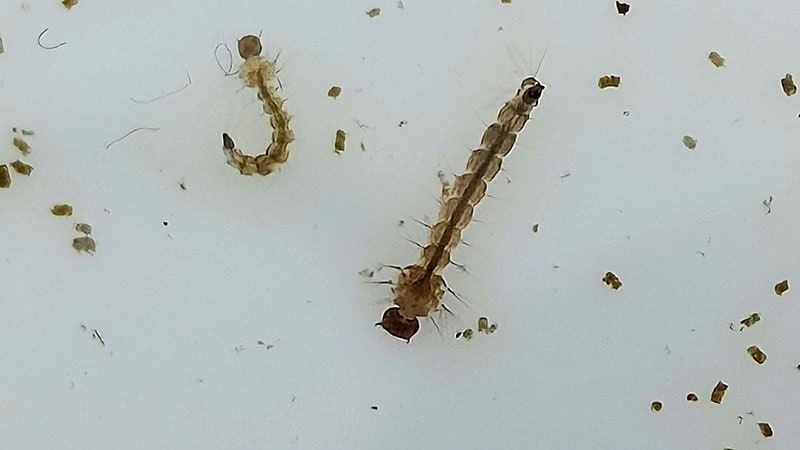Japanese encephalitis virus continues to spread in Australia. It has been detected in the country’s mosquito and arbovirus surveillance programs, as well as in feral pigs and commercial piggeries in most states and territories. The virus has claimed two lives this year and has been detected in mosquitoes collected in Queensland’s capital city, Brisbane, for the first time.
Japanese encephalitis virus was reported in regions of Australia for the first time in the summer of 2021-2022. At the time, experts described it as the “most significant local arbovirus emergency in almost 50 years.”
The outbreak, fueled by La Niña weather patterns, led Australia’s acting chief medical officer to declare the outbreak a Communicable Disease Incident of National Significance in March 2022. It resulted in 45 cases and 7 deaths.
“One of the most critical things now is that Australians realize that mosquitoes are not just an annoyance,” Cameron Webb, PhD, associate professor of medical sciences at the University of Sydney, Sydney, and medical entomologist at NSW Health Pathology, Newcastle, told Medscape Medical News. “In some parts of the country, they can kill you.”
Changing Epidemiology
Japanese encephalitis is a flavivirus related to dengue, yellow fever, and West Nile viruses. It is spread through bites from mosquitoes (primarily Culex tritaeniorhynchus) that become infected after biting infected pigs and waterbirds.
Japanese encephalitis is endemic in more than 20 countries across Southeast Asia and the Western Pacific. Between 67,500 and 100,000 cases are reported every year.
While most cases are mild (resulting in fever and headache) or asymptomatic, about 1 in 250 infections result in severe illness. Among patients who become severely ill, the case fatality rate can be as high as 30%. Up to half of severely ill patients develop lifelong neurologic, behavioral, or cognitive problems. Most cases occur in children younger than 15 years.
Before 2021-2022, Japanese encephalitis virus was considered to be limited to the far north of Australia. It was first detected in the Torres Strait Islands in 1995 and on the mainland in 1998 in the Cape York Peninsula.
In the summer of 2021-2022, Japanese encephalitis virus was detected in commercial piggeries in southeastern Australia, highlighting the virus’s changing epidemiology.
“Altered rainfall patterns and warmer temperatures affect mosquito breeding habitats and the distribution of reservoir hosts. These conditions can extend the mosquito season and expand the geographic range of mosquito vectors such as Culex species,” said Sarah McGuinness, MBBS, PhD, consultant physician in the Department of Infectious Diseases at the Alfred Hospital in Melbourne. McGuinness also is a senior research fellow at the School of Public Health and Preventive Medicine at Monash University in Melbourne.
Urban Spread
“Urbanization also plays a role by creating peri-urban environments where humans, livestock, and wildlife interact more closely, increasing the risk of spillover.”
While experts anticipated the virus to return in the 2023-2024 summer season, it didn’t return until 2024-25. Its detection in Australia’s third largest city was cause for concern.
“The emergence of Japanese encephalitis in mainland Australia and its spread to the southeastern states has been extremely concerning, particularly in relation to the high number of human cases and the impacts on pig farming due to reproductive losses in sows caused by the virus,” David Williams, PhD, group leader of diagnostics and mammalian infectious disease research at The Commonwealth Scientific and Industrial Research Organisation’s Australian Centre for Disease Preparedness, told Medscape Medical News.
 David Williams, PhD
David Williams, PhD
“The finding that the virus has been circulating in Brisbane is particularly concerning, given the additional risks to more densely populated areas,” Williams added. “Is Japanese encephalitis being reintroduced into the southern states from northern Australia, or is it wintering somewhere in the ecosystem and then reemerging when mosquito numbers start increasing? I don’t think we understand this yet…but unfortunately, I think we can expect further cases in Australia.”
Earlier this year, the World Health Organization released a technical brief on encephalitis (which many different pathogens can cause), stressing that it was a growing global concern “due to population density, intensive farming, climate change, vaccine hesitancy, and human-animal proximity.” It stressed the role that vaccination can play in preventing Japanese encephalitis.
Vaccination Efforts
Australia offers free vaccination for identified priority groups and patients living in certain local government areas deemed of concern. Risk areas are determined by state and territory health departments on the basis of surveillance data. Two vaccines are licensed in Australia. But while vaccination is available, public awareness is limited.
“There’s a real opportunity for healthcare providers to help raise awareness among the general population and among travelers,” McGuinness said. “We’re working to support these efforts by developing tools that facilitate conversations around Japanese encephalitis and vaccination.”
 Sarah McGuinness, MBBS, PhD
Sarah McGuinness, MBBS, PhD
McGuinness and colleagues have developed a Japanese encephalitis vaccine decision aid, which helps individuals assess their personal risk and make informed decisions.
Continuing to raise public awareness is key, said Webb. “We’re very lucky in that we are generally free of some of the serious mosquito-borne diseases that impact many countries, like malaria and dengue. But we need to remind the community that it’s important to take extra measures in some parts of the country to avoid mosquito bites.”
“We need to make people aware of the cheap and effective ways to protect themselves, such as how they dress, how they spend time near bushlands, and [how they use] repellent.”
Surveillance Strategies
Besides providing vaccination, Australia has also strengthened its surveillance systems, which include mosquito trapping and enhanced diagnostic capacity. But as Williams explained, affected states were able to capitalize on arbovirus surveillance programs that already were in place for other diseases. They pivoted to incorporate Japanese encephalitis into their sampling and testing activities.
“There has also been extensive work to sample wild animal populations such as waterbirds and feral pigs to understand their roles in the ecology of Japanese encephalitis virus,” said Williams. While the involvement of waterbirds had been well established, it’s unclear which other species are involved.
“Data and information sharing is another area that has been a focus across jurisdictions to make this more seamless,” Williams added. “[It is] inherently challenging but critical for decision-makers during outbreaks and for our broader understanding of the epidemiology of Japanese encephalitis across the nation…there’s still much we don’t know about Japanese encephalitis virus in Australia and much more research to do.”
Any information that can be gained will be helpful in filling in the gaps, Webb agreed. “The problem that we’re facing is that everything we previously knew about these types of viruses has recently been upended,” he said. “For me, it’s about thinking about how we can gather information to help professionals to make decisions by better understanding the parts of Australia at greater or lesser risk of regular activity of the virus.”
Webb, McGuinness, and Williams reported having no relevant financial relationships.


AloJapan.com